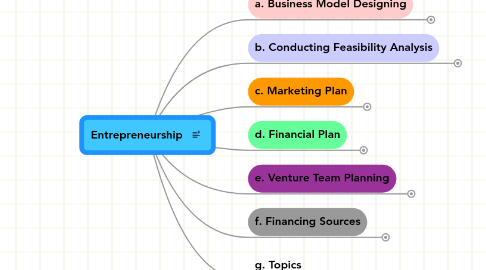
1. a. Business Model Designing
1.1. 1. Why & How must a business create competitive advantage
1.2. 2. Steps in the Strategic planning process
1.2.1. Develop a clear vision & translate into a mission statement
1.2.2. Assess the company's strengths & weaknesses
1.2.3. Scan the environment for opportunities & threats facing the business
1.2.4. Identify the key success factors
1.2.5. Analyze the competition
1.2.6. Create company goals & objectives
1.2.7. Formulate strategic options & select the appropriate strategies
1.2.8. Translate strategic plans into action plans
1.2.9. Establish accurate controls
1.3. 3. S-M-A-R-T goals & objectives
1.4. 4. Basic strategies
1.4.1. Low-cost
1.4.2. Differentiation
1.4.3. Focus
1.5. 5. Understand the importance of controls such as Balanced Scorecard in the planning process
1.6. 6. PowerPoint
2. b. Conducting Feasibility Analysis
2.1. a. Major components of Feasibility Analysis
2.1.1. Industry & market feasibility analysis
2.1.2. Product or service feasibility analysis
2.1.3. Financial feasibility analysis
2.2. b. Goal of feasibility analysis
2.3. c. Benefits of Preparing a Business Plan
2.4. e. Elements of a Business Plan
2.4.1. a. Executive summary
2.4.2. b. Mission statement
2.4.3. c. Company history
2.4.4. d. Business & Industry profile
2.4.5. e. Company's business strategy
2.4.6. f. Profile of products & services
2.4.7. g. Marketing strategy
2.4.8. h. Competitors' analysis
2.4.9. i. Owners' & officiers' resumes
2.4.10. j. Plan of operation
2.4.11. k. Financial data
2.4.12. l. Loan investment proposal
2.5. f. What the 5C of credit and their importance
2.5.1. Capital
2.5.2. Capacity
2.5.3. Collateral
2.5.4. Character
2.5.5. Conditions
2.6. g. PowerPoint
3. c. Marketing Plan
3.1. a. Principles & Benefits of Building a Marketing Plan
3.2. b. How can a business pinpoint their target market
3.3. c. Discuss the role of market research
3.4. d. Outline the market research process
3.5. e. Sources to develop competitive edge
3.5.1. Find a niche and fill it.
3.5.2. Use the power of publicity.
3.5.3. Don’t just sell; entertain
3.5.4. Strive to be unique.
3.5.5. Connect customers on an emotional level.
3.5.6. Create an identity for your business through branding.
3.5.7. Embrace social networking.
3.5.8. Start a blog.
3.5.9. Create online videos.
3.5.10. Focus on the customer.
3.5.11. Be devoted to quality.
3.5.12. Pay attention to convenience.
3.5.13. Concentrate on innovation.
3.5.14. Be dedicated to service.
3.5.15. Emphasize speed.
3.6. f. What the 4Ps of marketing & their role in a successful marketing strategy
3.6.1. Product
3.6.2. Place
3.6.3. Price
3.6.4. Promotion
3.7. g. PowerPoint
4. d. Financial Plan
4.1. 1. Importance of a Financial plan
4.2. 2. Describe how to prepare & use the basic financial statements
4.2.1. Balance sheet
4.2.2. Income statement
4.2.3. Cash Flows statement
4.3. 3. Create projected financial statements
4.4. 4. Categories of & understanding financial ratios
4.4.1. liquidity ratios
4.4.2. leverage ratios
4.4.3. operating ratios
4.4.4. profitability rations
4.5. 5. Break-even analysis
4.6. 6. PowerPoint
5. e. Venture Team Planning
5.1. 1. Entrepreneur as Leader
5.2. 2. Hiring the right employees
5.3. 3. Company culture for retention
5.4. 4. Management succession plan
5.5. 5. Exit strategies
5.6. 6. Powerpoint
6. f. Financing Sources
6.1. Importance of planning for capital requirements
6.2. Equity vs. Debt Capital
6.2.1. Differences
6.2.2. Advantages
6.2.3. Disadvantages
6.3. Sources of Equity capital
6.3.1. Personal
6.3.2. Family & friends
6.3.3. Angels
6.3.4. Partners
6.3.5. Corporations
6.3.6. Venture capital
6.3.7. Public stock offering
6.4. "Going public"
6.5. Sources of Debt capital
6.5.1. banks
6.5.2. asset-based lenders
6.5.3. vendors
6.5.4. equipment suppliers
6.5.5. commercial finance companies
6.5.6. savings & loans associations
6.5.7. stock brokers
6.5.8. insurance companies
6.5.9. credit unions
6.5.10. bonds
6.5.11. private placements
6.5.12. small business investment companies
6.5.13. small business lending companies
